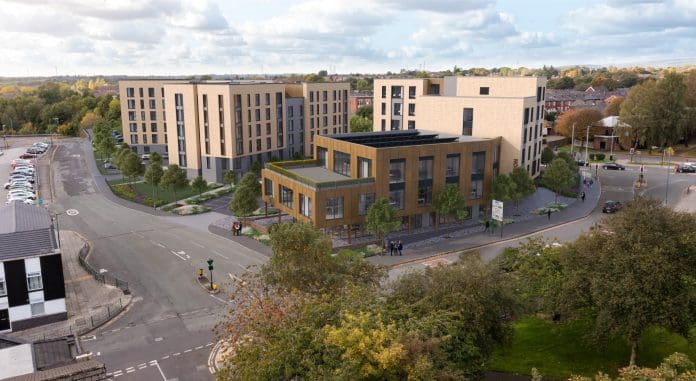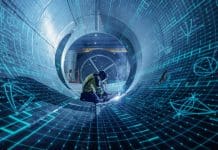Dan Thomason, co-founder of Rendernation, discusses why embracing the latest visualisation technologies can smooth out the bumpy planning process for developers, architects, and beyond
In architecture, planning, and development, time is money. Amidst an era of problematic supply chains and fluctuating costs, architect and property developer timelines cannot afford planning permission rejections.
They need their first application to be bulletproof. Embracing the latest architectural visualisation technology can, therefore, inject extra value into planning applications, streamlining the process and playing a key role in seducing decision-makers of the value of a project.
Answering all questions
If renders of a scheme are created in the most incredible detail, they can answer any lingering questions, which, with lesser quality CGIs, would ultimately slow down the approval process.
Delivering your planning application with a portfolio of hyper-real images, aerial shots, and interactive virtual tours, which make for an immersive and unrivalled experience, gives decision-makers all the information they need the first time they ask.
Gone are the days when properties-to-be are placed in a digital realm. Today, visual artists can place schemes within real-life photography, accurately embedding them within real-world environments.
It showcases a clear vision of a project’s look, feel, and scaling whilst revealing how it will blend into the surrounding area. If renders are developed with a keen attention to detail, then the benefits of a development can be straightforward to see, speeding up the approval process.
If there are knockbacks, high-quality renders can play an important role, too. The more accurate these visualisations are, the more pointed feedback will be, helping developers isolate the issues and quickly draw up viable conclusions.
The psychology of convincing CGI
Put simply, the more realistic an architectural visualisation looks, the more convincing it may be perceived by planning committees. Much like 1930s horror films, they typically fail to scare a modern audience as much as one with the modern, hyper-real CGI can. There’s simple psychology to visualisations.
The more realistic it looks, the more convincing viewers will find them. Whether this is to secure planning permission or achieve investment for a major project, when you’ve spent tireless hours labouring over a design, it would be amiss not to bring it to life the way it deserves. 3D renders should elevate a project’s value, not let its uniqueness down.
The virtual age
Interactive virtual tours can go the extra mile beyond static imagery. Creating immersive, 360-degree environments for users to explore and interact with offers increased value to a project. Moreover, when placed online, they’ve been shown to keep users glued to web pages for up to 10x longer.
Virtual tours can showcase every detail of a project in ways previously unexperienced. Having steadily developed in popularity since as early as 2007, there’s an argument too that, some 16 years later, virtual tours are expected more so than they are an appreciated bonus. They provide planning committees with greater exploration of a new project, allowing them to reach favourable conclusions far more quickly.
Investing in virtual tours early on can also help reap further rewards later. From showcasing a property, venue, or otherwise, on your website, businesses can help drive traffic and leads for various reasons. They don’t have to be a single-use investment.
Valuable verified views
Another rising trend is using accurate visual representations (AVRs) or verified views. An interactive quirk overlays two images with a click-and-draggable vertical slider where one image is seen on one side and the second on the other.
These are fantastic assets for before and after imagery, especially showing a photo of space as it is now, with the new development superimposed onto the second image so viewers can see the transformation in a unique, eye-catching way.
Due to their nature of being superimposed onto a real photograph, it offers imagery with unbridled transparency and scaling. For these images to work, they have to be wholly accurate and can, therefore, represent compelling evidence of the value of an architectural or development project.
Value amidst controversy
High-quality visualisation can be priceless when working on a potentially divisive project, as they leave no stone unturned. This is particularly true with redevelopment projects, including historic buildings or structures. Whether there is an element of conservatism breeding resignation to suggested changes, 3D renders can help ease concerns about heritage protection.
We recently created CGIs to redevelop the iconic 136-year-old Hammersmith Bridge in London. The project, dreamt up by architects Foster & Partners, devised a temporary double-decker bridge structure that would re-open the bridge to pedestrians whilst restoration works on the landmark bridge were carried out underneath.
In this instance, the provided 3D renders, supported by video montages, exhibited how both the temporary structure would look and perform and how the finished product would look once the £163m works are completed. These architectural visualisations were essential in telling the whole story of the bridge’s redevelopment to the broader community, with the landmark having been forced to close to the public in 2020.
Winning the public vote
A broadly common reason for building plans not being granted is pushback from residents. Often, a concern is that the proposal will look out of character with the surrounding area. Photo-real aerial photomontages, which blend real-life photography with sensitively embedded 3D architectural visualisations today, can help give councils, residents, and others a macro view of the project.
They can see how it will nestle into the surrounding environment, which can help get the public on board, as they can get a clear vision as to how the new build will sit into the existing environment.
When it comes to convincing planning committees of a project’s excellence, high-quality 3D renders can be a secret weapon. By answering all questions in one fell swoop, creating immersive experiences and making a project look as real as possible, developers can speed up their planning processes and get to work with what they do best.

















